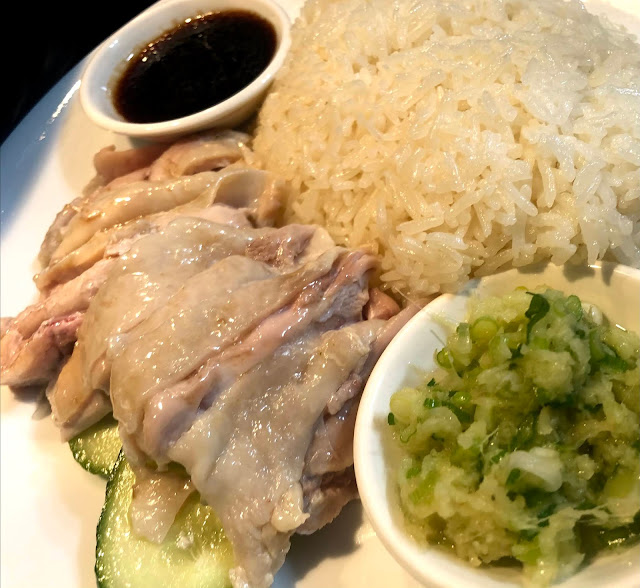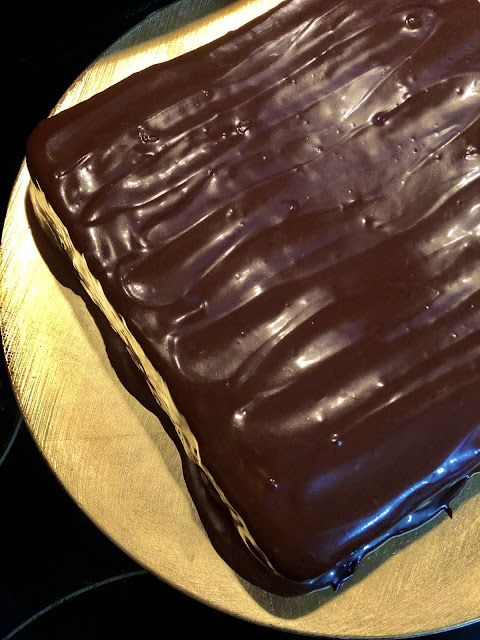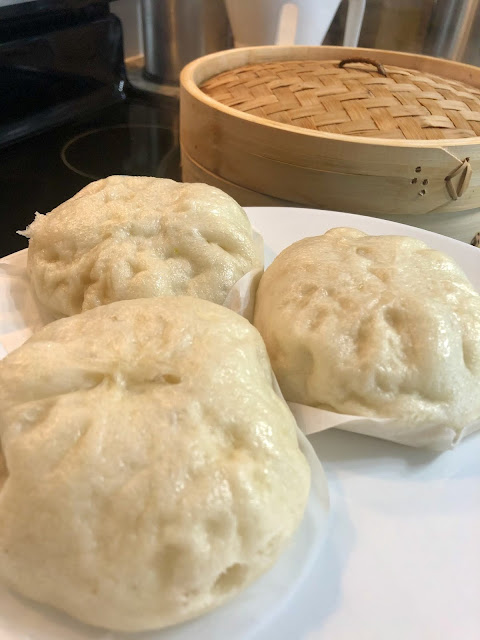Recipe: Homemade Basil Pesto

I'm often dumbfounded when I buy a bunch of herbs and ONLY need a couple for a recipe. I always try to use up my ingredients so I don't throw out anything. That's why when I cook, it's always just enough and portioned - that way everything is consumed.
I remember buying basil because I wanted to make a Caprese salad because I needed a light lunch (mainly because I knew I was going to have a full-on steak dinner later that night). Caprese is basically a salad of sliced fresh Roma tomatoes, sliced fresh mozzarella, basil leaves, balsamic reduction, and seasoned with salt and pepper. But then, I realized I had to buy the whole bunch of basil and would really just use a couple of leaves. So I made a basic basil pesto to utilize the whole bunch. Plus, I was able to keep it longer in the chiller.
Pesto literally means "to pound or to crush", like "pestle" (from mortar and pestle). So you're making a pestled melange of herbs. Now this term is mostly associated with it being made with basil. But pesto can mean an array of herbs (like parsley, coriander, arugula, etc.) - you'll see this mostly in artisan gourmet shops or in menus where chefs are more creative in interpreting the pesto products. You can serve pesto in pasta, to spread on bread, a base for flatbreads or even pizza, an addition to a an antipasto spread, or an addition to steamed mussels.
I enjoy making homemade basil pesto because you can control how much of each ingredient you want. I generally can't take too much fresh garlic because it's flavour is too strong and it's highly acidic. Also, you can choose how much pine nuts and salt content you add, in this case, your salt will come from the cheese you put (Parmesan, Parmigiano Regiano, or pecorino Romano). It's best made with freshly grated cheese but I won't judge you if you use the store-bought kind in a cheese canister. Just watch out because these are generally saltier than the freshly grated kind (so it can stay on the grocery shelf longer). Luckily for us, our local Italian deli offer tubs of freshly sliced wedges of hard cheese and freshly grated varieties.
=================================================
Basil Pesto
This will make about a cup (or a little less than a cup). If you plan to store this, it can fill up a small jam jar (Yup, I keep these jars in case I need to store anything. Like a true Filipino, you can re-use containers. 🤣)
You'll need a skillet, a food processor (or a chopper if you have one), and a spatula.
Ingredients
1/4 cup pine nuts
1 1/2 to 2 cups fresh basil leaves, washed and dried (Use a salad spinner to dry it out completely.)
2 cloves fresh garlic (If you want a more garlicky taste, you can add more.)
1/4 cup freshly grated parmesan (As I mentioned above, you can also use other hard cheeses just taste it before you make the pesto so you can adjust the saltiness.)
1/4 cup extra virgin olive oil
pinch of salt and pepper to taste (I generally don't add any more salt to it. If I do add, I keep it to a minimum like 1/8 tsp each of salt and pepper.)
Procedure
I remember buying basil because I wanted to make a Caprese salad because I needed a light lunch (mainly because I knew I was going to have a full-on steak dinner later that night). Caprese is basically a salad of sliced fresh Roma tomatoes, sliced fresh mozzarella, basil leaves, balsamic reduction, and seasoned with salt and pepper. But then, I realized I had to buy the whole bunch of basil and would really just use a couple of leaves. So I made a basic basil pesto to utilize the whole bunch. Plus, I was able to keep it longer in the chiller.
Pesto literally means "to pound or to crush", like "pestle" (from mortar and pestle). So you're making a pestled melange of herbs. Now this term is mostly associated with it being made with basil. But pesto can mean an array of herbs (like parsley, coriander, arugula, etc.) - you'll see this mostly in artisan gourmet shops or in menus where chefs are more creative in interpreting the pesto products. You can serve pesto in pasta, to spread on bread, a base for flatbreads or even pizza, an addition to a an antipasto spread, or an addition to steamed mussels.
I enjoy making homemade basil pesto because you can control how much of each ingredient you want. I generally can't take too much fresh garlic because it's flavour is too strong and it's highly acidic. Also, you can choose how much pine nuts and salt content you add, in this case, your salt will come from the cheese you put (Parmesan, Parmigiano Regiano, or pecorino Romano). It's best made with freshly grated cheese but I won't judge you if you use the store-bought kind in a cheese canister. Just watch out because these are generally saltier than the freshly grated kind (so it can stay on the grocery shelf longer). Luckily for us, our local Italian deli offer tubs of freshly sliced wedges of hard cheese and freshly grated varieties.
=================================================
Basil Pesto
This will make about a cup (or a little less than a cup). If you plan to store this, it can fill up a small jam jar (Yup, I keep these jars in case I need to store anything. Like a true Filipino, you can re-use containers. 🤣)
You'll need a skillet, a food processor (or a chopper if you have one), and a spatula.
Ingredients
1/4 cup pine nuts
1 1/2 to 2 cups fresh basil leaves, washed and dried (Use a salad spinner to dry it out completely.)
2 cloves fresh garlic (If you want a more garlicky taste, you can add more.)
1/4 cup freshly grated parmesan (As I mentioned above, you can also use other hard cheeses just taste it before you make the pesto so you can adjust the saltiness.)
1/4 cup extra virgin olive oil
pinch of salt and pepper to taste (I generally don't add any more salt to it. If I do add, I keep it to a minimum like 1/8 tsp each of salt and pepper.)
Procedure
1. Heat your skillet on medium and toast the pine nuts. You'll see each side brown and you'll smell the oil. Make sure you toss them about on the skillet to ensure both sides of each pine nut is browned well.
2. In a food processor, add the basil, garlic, cheese, and half of the olive oil. Continue to pulse to finely chop the ingredients. Slowly add the remaining oil to ensure it's incorporated well.
3. Taste and season according to your liking.
4. Store for keeping or enjoy immediately!
Storage
You can store this for a couple of weeks in the chiller. Another option would be to freeze portions of this with an ice cube tray. Just fill the slots with the pesto and let it freeze for about 1-2 hours. Transfer these cubes to a ziplock bag and you can store for about 2 months.
----------------------------------------------------
*In the photo above, I still used the pesto on a Caprese salad - I replaced the basil leaves with the pesto. I served this salad as a side to a creamy shrimp and cod bake.
**If you want to make this the traditional way, you'll need a mortar and pestle. You start with pounding the pine nuts, garlic and basil leaves, slowly incorporate the oil, and lastly, add the cheese.
***I use Extra Virgin Olive Oil because of its sweet and nutty taste. This type of olive oil is best for seasoning, dipping, or sauces. This generally tastes better because this is the first, cold-pressed batch the olives, producing the olive oil. Other types include Virgin Olive Oil, Light Olive Oil, Refined Olive Oil, and of course - all the other flavoured and infused olive oils.
#donyaluzee #food #recipe #basilpesto #pesto #basil #oliveoil #parmesan #parmesancheese #pecorino #pecorinoromano #parmigiano #parmigianoregiano











Comments
Post a Comment